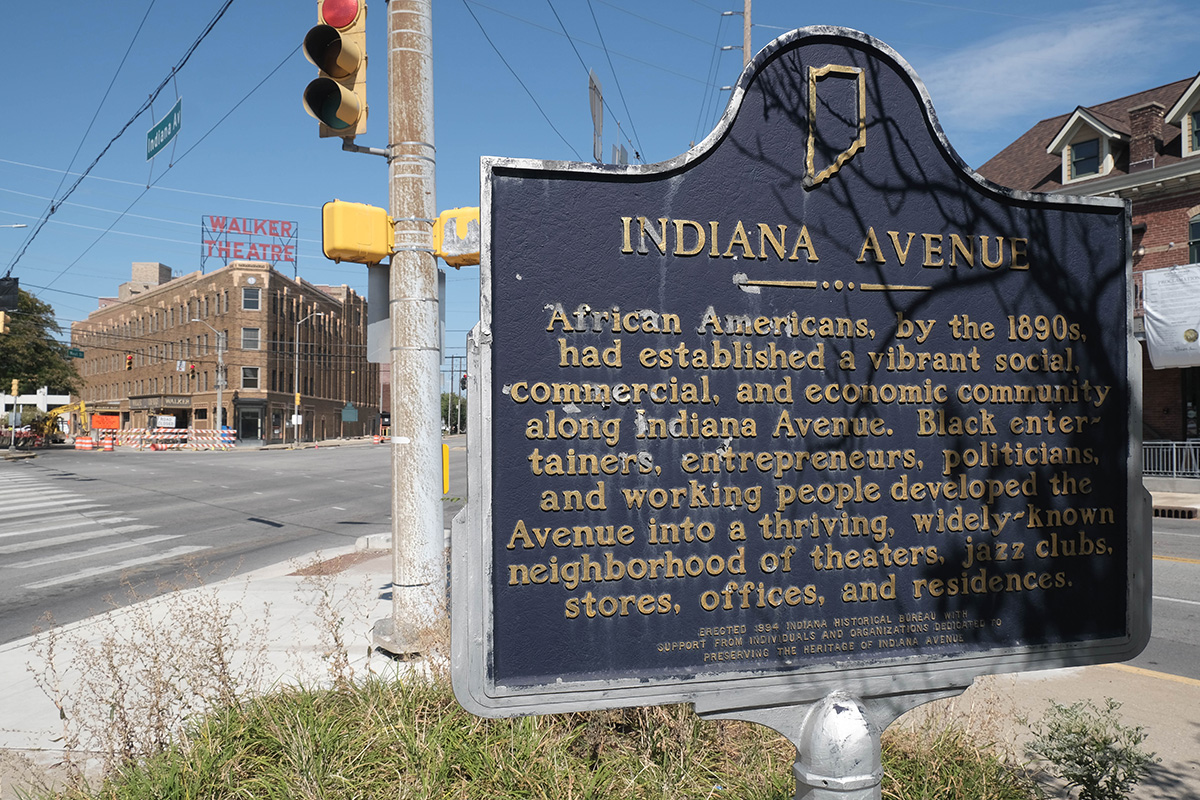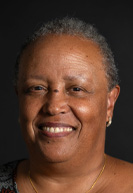Subscriber Benefit
As a subscriber you can listen to articles at work, in the car, or while you work out. Subscribe Now
City officials have hired an out-of-state firm to create a strategic development plan for the Indiana Avenue corridor, a part of downtown Indianapolis that has seen neighbors push back on recent project proposals in favor of a more comprehensive real estate approach.
Brooklyn-based Elizabeth Kennedy Landscape Architect PLLC will be paid about $450,000 to develop the plan, which is to be based on extensive discussion with community members, neighborhood organizations, city staff and other consulting firms to determine how to develop the avenue to honor its past as a local epicenter of Black commerce.
Purdue University is expected to spend about $250,000 to supplement the consulting firm’s fee, while New York City-based Mellon Foundation is funding an additional $150,000. The remainder will be paid using revenue from the city’s downtown tax-increment-financing district.
The firm’s selection by a panel of community members followed a request for expressed interest, or RFEI, released in February by the city. That request solicited ideas for how to best set development priorities for the avenue and surrounding neighborhoods.
“This team is going to be listening to everyone out here,” said Judith Thomas, deputy mayor of neighborhood engagement for Indianapolis. The stakeholders’ “concepts, their feelings—you have to take them all into consideration. People are going to have different viewpoints, but they’re all going to add to the process.”
Fourteen firms responded to the RFEI, with at least eight seriously considered after having met all the bid requirements. Among them was a response led by Indianapolis-based Meticulous Design—one of the city’s only Black-owned architectural firms.
Thomas said while Elizabeth Kennedy Landscape Architect is not located in Indianapolis, it will be expected to work with multiple local firms to develop the plan for an area generally bounded by 16th Street to the north, Capitol Avenue to the east, Military Park and the NCAA headquarters to the south and the White River to the west.
The boundaries—which expand the planning area beyond just Indiana Avenue—are expected to lead to a more cohesive plan for downtown’s northwest quadrant, which also includes IUPUI (which next year will be split into IU Indianapolis and Purdue University at Indianapolis) and the 16 Tech Innovation District, as well as multiple hospitals.
“As vision lead, EKLA will act as the logistical platform for planning, design, and Indianapolis-based thought leaders to elevate their expertise and drive Indiana Avenue forward with a plan centered on community input,” Elizabeth Kennedy, owner of Elizabeth Kennedy Landscape Architect, said in a statement.
“The team plans to fully embed in Indianapolis to understand the city’s culture and maneuver through its historical and contemporary Black space,” she said. “EKLA approaches community input through the lens of history, culture and inclusion. It drives how the team thinks about the design of cities and shapes how it will welcome everyone to the table throughout this process.”
The plan marks only a first step of what’s likely to be a years-long process that aims to connect Indiana Avenue back to its roots and to create a new path forward. To be effective, the plan would need to be adopted by the city and considered as part of future development proposals that go before the Metropolitan Development Commission and other bodies.
EKLA’s proposal is expected to identify areas for affordable and mixed-use housing projects, culturally anchored spaces and public spaces and new infrastructure. It’s also meant to identify opportunities to attract public and private investment and propose ways to attract new businesses.
City officials say the plan must ensure the district’s four residential areas—Ransom Place, Fayette Street, Flanner House Homes and Watermark—retain their own identities as part of a larger development vision that ties each end of Indiana Avenue together.
A’Lelia Bundles, a journalist and descendent of Madam CJ Walker, after whom the Walker Theatre is named, was on the panel that chose EKLA to create the strategic plan. She said the move is an important step for the city, particularly as it looks to ensure that residents gain a voice in what happens to vacant or underdeveloped parcels.
“This is really the last opportunity to reference some of the heritage” of the area through future development efforts, Bundles said. “It’s really important that we do that, as it’s such valuable property from the standpoint of the city’s identity.”

Buckingham pushback
The move to create a strategic plan for the area comes two years after neighborhood residents formed a coalition called Reclaim Indiana Avenue to push back on a proposed $70 million development proposed by Indianapolis-based Buckingham Cos. The project was to include nearly 350 apartments, a parking garage and retail space at 719 Indiana Avenue, adjacent to the Madam Walker Legacy Center, which owned the site. The apartments had been earmarked for market-rate uses and students at IUPUI.
The development drew the ire of community groups who were concerned it would overshadow the Walker and risk further erasing the neighborhood’s historically Black culture. Buckingham eventually withdrew its plans.
Bundles said she hopes the lessons learned by the city and private developers from the Buckingham situation will serve as a springboard to create something special for Indiana Avenue through the EKLA plan that takes diverse opinions of the neighborhood into account.
The previous proposal “would have killed any opportunity to imagine something other than yet another building that doesn’t create community,” Bundles said. “So, for me, it’s about how we create community along Indiana Avenue with the same amount of vision and the same amount of interest that has gone into Bottleworks.”
Rodney Byrnes, CEO of development firm Arrow Street Development, is bullish on the neighborhood. He has acquired the parcel at 501 Indiana Avenue—adjacent to the Kurt Vonnegut Museum—and is in the early stages of potential redevelopment there. The Madam Walker Legacy Center is also entertaining options for the 719 Indiana Avenue parcel that was set to be developed by Buckingham.
But he doesn’t plan to make any decisions about his development projects until a strategic plan for the neighborhood is finalized.
Like Bundles, Byrnes compared the corridor with Massachusetts Avenue, calling it “some of the best real estate in town,” and said it presents a unique opportunity to be another burgeoning part of the city in the coming years with the right development and investment strategy.
“As long as everyone’s on the same page and we’re working together, this is going to be one of the greatest examples of community redevelopment in the country—I really think it’s going to be special,” he said. “A plan like this is a way to kind of start creating that framework.”
Setting a tone
Paula Brooks, leader of Reclaim Indiana Avenue and another member of the advisory panel that selected EKLA, said she expects there will be some differences of opinion about what should be done with unused parcels—and those that could become available for redevelopment in the coming years.
Brooks said EKLA should engage specifically with those living in senior or supportive housing in the area and others who do not own property but live in the area to ensure they have a voice in the neighborhood’s future.
She also said that by making the plan a “living document” rather than setting everything in stone would be wise, particularly as Purdue looks to begin work on establishing a stronger presence in Indianapolis on a portion of the current IUPUI campus.
In fact, Purdue has earmarked 28 acres—largely parking garages and surface lots—for its first project in the area. It will lease the land just south of Indiana Avenue and north of Michigan Street, near West Street to build a campus center, dorm space and other amenities.
“I’m sure that area [of the plan] will be different in five years, just like the neighborhood is different now than it was five years ago,” Brooks said. “So, [the plan] has to be flexible.”
The southern end of Indiana Avenue isn’t the only area that’s on the rise. Development continues on parts of 16 Tech, which sits east of the White River and north of Fall Creek along Indiana Avenue, including nearly 290 new apartments and preleasing for two lab-focused office buildings.
Emily Krueger, CEO of 16 Tech Community Corp., said the effort to develop a plan for Indiana Avenue is vital to the neighborhood’s long-term health and says the innovation district can play a role in those efforts.
16 Tech has already sought to support the neighborhood’s entrepreneurs, she said. Of the 25 food vendors at The AMP food hall on the campus, at least five have connections to the surrounding neighborhood. Outreach efforts also continue as the district tries to identify companies—including startups—that could benefit from space at 16 Tech.
“We have the opportunity in what we’re doing here to support and seed the growth of retail businesses that could locate on Indiana Avenue and help be part of a restoring Black-owned commerce on the avenue,” Krueger said. “So, we’re actively helping support the formation and development of businesses and social enterprises that have the potential to scale and take a place of ownership along the avenue in the future.”

What comes next
But there are some who are skeptical of the city’s hiring of EKLA, both because the firm isn’t based locally and because there’s no consensus among neighbors about what they want to see in the neighborhood.
Olon Dotson is chair of the department of architecture and an associate professor at Ball State University, an Indiana Avenue historian and also a construction manager for Dorsey Architects & Associates Inc., which was a partner on the Meticulous strategic proposal to the city.
He said he is disappointed that the bid wasn’t selected for the project, and he has concerns about the lack of a “unified voice” from the neighborhood.
“They don’t have a singular vision of what should … happen, but they do have a singular vision on what should not happen,” Dotson said, referring to the pushback against Buckingham’s project.
Dotson said the city is taking the right approach in developing a plan, but he said he’s not overly optimistic the project will gain much ground.
“If there’s no master plan, then developers could just come in here willy-nilly and just complete the process of erasure—you’d never know that there was an African American community there,” he said. “I’m just going to sit back and watch what happens. But I’m not optimistic or expecting anything revolutionary.”
Brooks, from Reclaim Indiana Avenue, said the decision to go with an outside firm was the right move.
“I personally prefer the fact … that the firm is not from here, at least the principal of it,” she said. “At least this [group] can come in and kind of look at the entire corridor with a new eye, so I appreciate that.”•
Please enable JavaScript to view this content.









Cool.
The majority of firms submitting proposals had lots of resources and a breath to project experience and fell short. I understand that EKLA will have “extensive discussion” to get “community input.” Beyond that, what is inspires particular confidence this landscape architect will create a compelling plan for a large urban district. Has EKLA put forth a preliminary vision yet, or did they sell the committee on a process alone? The article doesn’t seem to explain clearly what led to the committee’s selection of EKLA and why all the prior proposals fell short. Can we get some insight about that and what the other proposals were lacking or what while likely differentiate at plan by EKLA?
Rather that sit back and watch what happens, other firms or their representatives could actively particpate in the process rather than continue to fume about not having bern selected.
And being local does not provide, ipsp facto, and absolute right or a preponderance od wisdom to develop a plan.
Endless surface parking must be given over to a highe and better, complementary urban use. Proposing [more] soulless suburban design plans need not be done.
A plan should be put forward that incorporates contiguous development designed for foot traffic but accommodating multi-modal vehicular access. The current West Street super arterial is a dreadful concrete corridor, a prime example of what should never be done again — too bad that a re-visioning of this massive roadway is not part of the scope.
“Development continues on parts of 16 Tech, which sits north of the White River along Indiana Avenue, including . . . “. Incorrect description.
The 16 Tech development is east [not north] of White River and north of Fall Creek.
Nobody (company) can honor the Indianapolis area and history like a New York City Firm. Boondogle.
For all the naysayers about selecting an out of state firm, keep in mind they were selected by community representatives and will have local firms on the team.
still a naysayer. $450k ? Really? Who were those community reps? No Local firms were qualified? All the talk about supporting local businesses is just that…. Talk.
Have there been any public hearings to gather input from the Indiana Avenue constituents and other residents of Indianapolis? Seems like a good place to start before selecting an out of state agency.